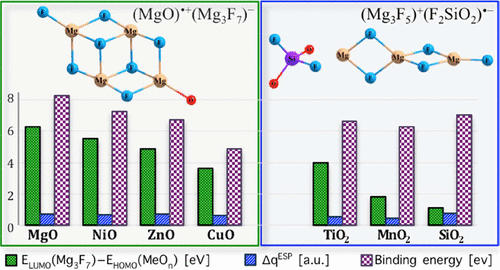当前位置:
X-MOL 学术
›
J. Phys. Chem. A
›
论文详情
Our official English website, www.x-mol.net, welcomes your
feedback! (Note: you will need to create a separate account there.)
Oxidizing Metal Oxides with Polynuclear Superhalogen: An ab Initio Study
The Journal of Physical Chemistry A ( IF 2.7 ) Pub Date : 2018-08-24 00:00:00 , DOI: 10.1021/acs.jpca.8b05095 Celina Sikorska 1
The Journal of Physical Chemistry A ( IF 2.7 ) Pub Date : 2018-08-24 00:00:00 , DOI: 10.1021/acs.jpca.8b05095 Celina Sikorska 1
Affiliation

|
The ability of metal oxides (CoO, CuO, MgO, MnO2, NiO, SiO2, TiO2, and ZnO) to form stable systems with polynuclear superhalogen (i.e., Mg3F7) is examined on the basis of theoretical considerations supported by ab initio calculations. It is demonstrated that the MeOn (n = 1, 2) molecules (such as CoO, CuO, MgO, MnO2, NiO, TiO2, ZnO) should form stable and strongly bound (MeOn)+(superhalogen)− salts when combined with the Mg3F7 superhalogen radical (acting as an oxidizing agent). This conclusion is supported by providing: (i) structural deformation of superhalogen upon ionization, (ii) predicted charge flow between each MeOn and superhalogen (which allows estimating the amount of electron density withdrawn from MeOn molecule during the ionization process), (iii) the localization of the spin density distribution, and (iv) the interaction energies and vertical ionization potentials (VIPs) for the compounds obtained at the CCSD(T)/6-311+G(d) level of theory. On the other hand, the Mg3F7 superhalogen was found to be incapable of ionizing molecules whose adiabatic ionization potentials (AIPs) exceed 12 eV (e.g., SiO2). I believe that the results provided in this contribution may likely be of prospective relevance in the future studies on the issue of binding and preventing metal oxide nanoparticles aggregation in the environment before they occur harmful to human health and environment.
中文翻译:

用多核超级卤素氧化金属氧化物:从头算研究
基于支持的理论考虑,研究了金属氧化物(CoO,CuO,MgO,MnO 2,NiO,SiO 2, TiO 2和ZnO)与多核超卤素(即Mg 3 F 7)形成稳定体系的能力。通过从头开始计算。结果表明,MeO n(n = 1,2)分子(如CoO,CuO,MgO,MnO 2,NiO,TiO 2和ZnO)应形成稳定且牢固结合的(MeO n)+(超卤素)-盐与Mg 3 F 7结合使用时超卤素自由基(用作氧化剂)。提供以下结论可支持该结论:(i)电离时超卤素的结构变形;(ii)每个MeO n和超卤素之间的预测电荷流(这允许估计在电离过程中从MeO n分子中抽出的电子密度的量),( iii)自旋密度分布的局部化,以及(iv)在CCSD(T)/ 6-311 + G(d)理论水平下获得的化合物的相互作用能和垂直电离能(VIP)。另一方面,发现Mg 3 F 7超级卤素不能电离绝热电离电势(AIPs)超过12 eV的电离分子(例如,SiO 2)。我相信,此贡献提供的结果可能与将来在结合和防止金属氧化物纳米颗粒在对人体健康和环境有害之前在环境中聚集的问题具有潜在的相关性。
更新日期:2018-08-24
中文翻译:

用多核超级卤素氧化金属氧化物:从头算研究
基于支持的理论考虑,研究了金属氧化物(CoO,CuO,MgO,MnO 2,NiO,SiO 2, TiO 2和ZnO)与多核超卤素(即Mg 3 F 7)形成稳定体系的能力。通过从头开始计算。结果表明,MeO n(n = 1,2)分子(如CoO,CuO,MgO,MnO 2,NiO,TiO 2和ZnO)应形成稳定且牢固结合的(MeO n)+(超卤素)-盐与Mg 3 F 7结合使用时超卤素自由基(用作氧化剂)。提供以下结论可支持该结论:(i)电离时超卤素的结构变形;(ii)每个MeO n和超卤素之间的预测电荷流(这允许估计在电离过程中从MeO n分子中抽出的电子密度的量),( iii)自旋密度分布的局部化,以及(iv)在CCSD(T)/ 6-311 + G(d)理论水平下获得的化合物的相互作用能和垂直电离能(VIP)。另一方面,发现Mg 3 F 7超级卤素不能电离绝热电离电势(AIPs)超过12 eV的电离分子(例如,SiO 2)。我相信,此贡献提供的结果可能与将来在结合和防止金属氧化物纳米颗粒在对人体健康和环境有害之前在环境中聚集的问题具有潜在的相关性。











































 京公网安备 11010802027423号
京公网安备 11010802027423号